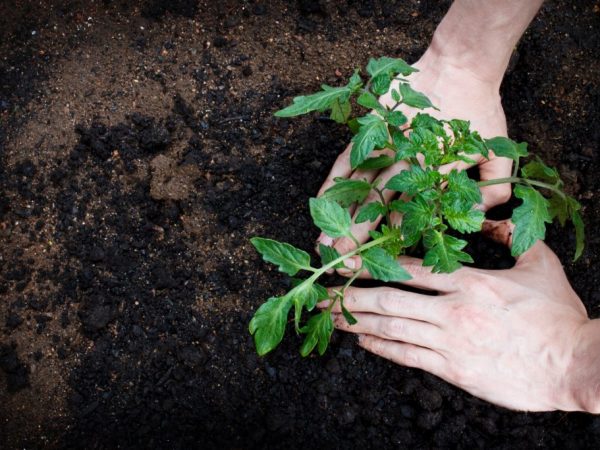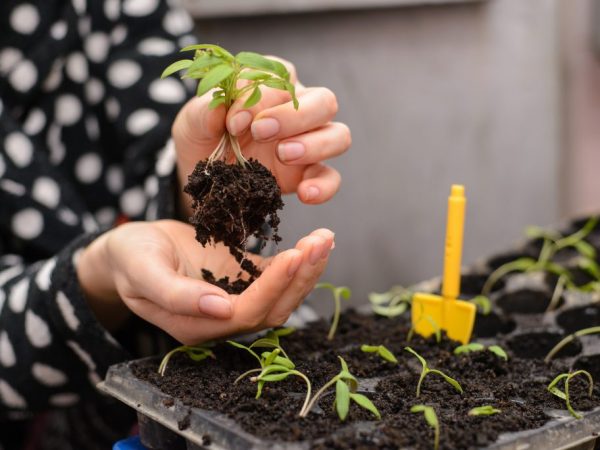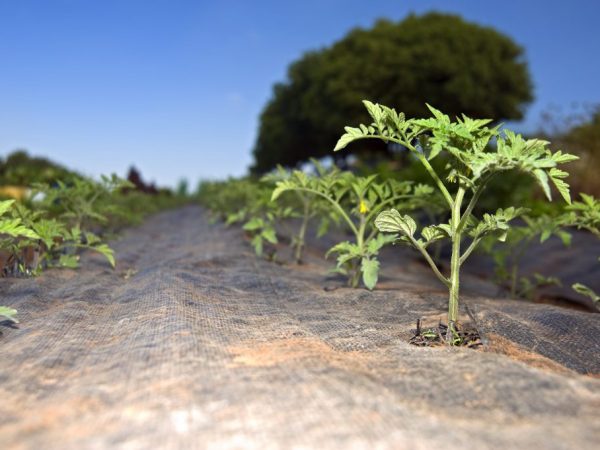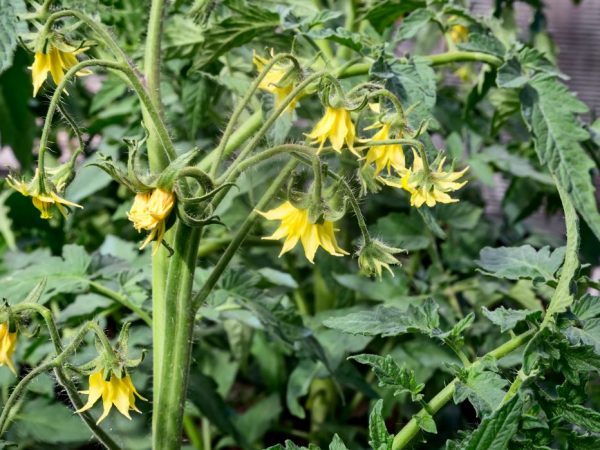Growing tomatoes
To get a high yield from a plant, it is important to know all the intricacies of agricultural technology. How to organize natural cultivation of tomatoes? Consider how to care for tomatoes.

Growing tomatoes
Conditions for development
To get the most out of your plant, it's not enough to just bury the seeds in the ground. There are conditions under which the culture grows well and bears fruit. Ignoring these factors has negative consequences.
Temperature
Growing tomatoes is necessary at a certain temperature. The air should warm up to 23 ° C during the day, and not lower than 17 ° C at night. If the heat drops to 13 ° C, the plant absorbs nutrients poorly from the soil and liquid. This condition is especially dangerous in cloudy weather: lack of lighting and cold can quickly destroy plantings.
Seedlings are threatened with recurrent frosts, which often occur after planting in open ground. At first, it is better to cover the bushes with polyethylene at night. It is preferable to measure the soil with an ordinary thermometer. If the ground warms up to 10 ° C, you can start work.
Growing should be warm, but heat is just as dangerous as cold. At temperatures above 35 ° C, foliage begins to wilt, the pollen becomes sterile. In the sweltering heat, the plantations are shaded with a light cloth, scattering the aggressive rays of the sun.
Plot
When growing tomatoes in the open field, it is advised to choose the southern or southeastern parts of the garden. Plants developing near bushes or a chain-link fence will show a good result. It is bad to grow the culture in soil with high acidity, therefore in the fall it is advised to deacidify the soil with lime - 500 g per 1 sq. m.
According to the rules for growing tomatoes, tomatoes and related plants (peppers, eggplants, potatoes) cannot be planted in one place for more than 2 years in a row. If the crop rotation is violated every year, the culture gradually degenerates. The best predecessors are:
- cabbage;
- bow;
- zucchini;
- cucumbers.
The plot for tomatoes must be prepared in the fall. The earth is carefully dug up, weeds are removed, after which the soil is mixed with fertilizers. For 1 sq. m you need to add 5 kg of organic matter and 50 g of superphosphate. In the spring, after loosening, 40 g of nitrogen preparations are introduced.
How to plant
How to plant tomatoes correctly? One of the most accessible technologies is the seedling method. For several weeks, the plants are developed indoors, after which they are planted in open ground or in a greenhouse. During this period, the bushes have time to mature, and the temperature outside becomes suitable.
Seed preparation
To grow early tomatoes, you must soak the seeds in advance in a growth promoter, and then leave them on a napkin for germination. Then they prepare containers for planting - seedling cassettes or peat pots.Drainage and a mixture of nutrient soil and compost are poured inside. The seed is planted to a depth of 2 cm. The thicker the soil layer, the longer the plant germinates.
Tatiana Orlova (Candidate of Agricultural Sciences):
Seeds on sale are already treated with growth stimulants or a disinfecting composition. To warn about this, a special bright dye is introduced into such compositions. Such "colored" seeds should not be soaked in water or growth promoter.
After the work is completed, it is sprayed from the top with a spray bottle and covered with polyethylene. The containers are placed in a bright, warm place for a period of 4 to 20 days. How long does it take for tomatoes to sprout in a greenhouse? The timing of hatching depends on the quality of the seeds and the suitable conditions. Optimally, the culture wakes up at a temperature of 22 ° C.
After the emergence of shoots, the shelter is removed and the heat is reduced to 18 ° C. During this period, the farmer is required to regularly loosen the land and moderate watering. The recommended daylight hours must be increased to 14 hours a day. Before planting in open ground, seedlings are gradually accustomed to low temperatures for a week.
Dive

When transplanting, part of the root must be cut
When growing tomato seedlings, one must not forget about the picking procedure. After the seedlings have 3 true leaves, it is necessary to transplant into a larger container. When diving, the strongest bushes are chosen, and the rest are thrown away.
Carefully pull the seedling out of the pot, being careful not to damage the roots and stalk. Farmers recommend using a teaspoon for these purposes, which is used to dig up a plant with a clod of earth. Tomatoes become stronger and more resilient faster after the operation.
Tatiana Orlova (Candidate of Agricultural Sciences):
This technique is called picking because a sharp wooden stick is used to dig up plants - a pike.
A repeated procedure is relevant if the seedlings have grown, and for a long time before planting in open ground. The bushes are pulled out of containers, part of the root is cut off and planted again. The plant begins to spend energy not on growing tops, but on restoring underground parts.
Landing rules
The site is pre-dug up, after which a place is formed according to the scheme:
- between the bushes - 50 cm;
- between rows - 60 cm;
- between the beds - 70 cm.
If crops are planted at such a distance, they will be able to receive moisture in the amount necessary for normal growth and development.
Tatiana Orlova (Candidate of Agricultural Sciences):
The planting scheme for tomato plants also depends on the variety. As a rule, early maturing (and even more so, super early maturing) varieties are small in size. They are planted according to the scheme 50 x 30 cm - 50 cm - distance between rows, 30 cm - distance between bushes in a row. Large-fruited varieties are planted according to the planting scheme 70 x 35 - 40 cm.
Growing tomatoes involves observing the following rules: planting in a checkerboard pattern. The average depth of the holes is 40 cm, although it all depends on the development of the root system at the seedlings. In addition to the plant, the hole will contain a drainage layer and a fertilizer cushion. The bushes are carefully pulled out of the containers, being careful not to damage the lower parts. When planting with seeds, the material is deepened into the ground by 2 cm.
Before agricultural work, the holes are watered with hot water: this way it is possible not only to saturate the soil with the moisture necessary for development, but also to warm up the earth. After planting in a permanent place of growth, the seedlings are covered with polyethylene from frost at night.
Unusual cultivation methods
There are many interesting technologies that allow open field tomatoes to grow even better. Each gardener selects new and original methods that suit his needs.
In bags
What if the plot is too small for growing tomatoes? Mobile beds are one of the easiest ways to harvest delicious vegetables at home.Structures can be placed in any convenient place, controlling the lighting and temperature next to them. When cultivating in bags, you do not need to worry about the quality of the land, because the farmer prepares the soil mixture at his own discretion.
For the construction of the beds, you will need strong volumetric packages (from under cereals or for construction waste) of 50 liters. In order for the water to drain well, it is necessary to cut off the corners and make additional drain holes along the bottom. New bags are filled with layers:
- drainage (broken bricks, vermiculite, sand);
- compost;
- nutrient earth.
Humus takes up more than 50% of the garden bed, so there is no need to feed the plants throughout the growing season. A rope is pulled over the mobile structures: it will act as a trellis. The top is tucked in, and wooden sticks are inserted into each package for support.
Seedlings are planted in 2 bushes in one container. The earth is pre-moistened, after which holes are made and the culture is fixed.
Recommendations
Secrets of growing tomatoes:
- Watering. The water in polyethylene dries slowly, so it is necessary to control the humidity and prevent the soil from acidifying or drying out. In regions where it is constantly hot in summer, the irrigation procedure is repeated every 3 days.
- Loosening. Good aeration is essential for normal growth.
- Garter. By fixing the stem on the trellis, it will be possible to protect the structure from overturning.
As the bushes develop, fresh soil is added, covering the bare roots. After the harvest is harvested, the used soil is thrown away. The bags will last for more than one year, but before the next planting, it is necessary to disinfect the polyethylene.
Warm bed

You can make warm beds for seedlings yourself
If growing tomatoes in the open field is problematic, it is worth trying to organize structures in heated boxes. For this, the boards are assembled in the form of boxes, the width of which is at least 45 cm. The length can be of any length, allowing you to use the entire space.
Broken brick is laid at the bottom of the structures, and then a layer of humus and nutrient soil. A thick layer of compost completes the cake. Organic debris melts and heats the soil, resulting in a warm bed creating ideal conditions for plants to grow in cooler regions. Such crops are not afraid of frost, exhibit amazing characteristics of germination and vitality.
When growing tomatoes in boxes, you need to organize a reliable tying. Bushes grow quickly, so a trellis is needed. To do this, a rope is pulled over the boxes or arch brackets are installed. For the winter, the structures are covered with plant residues and covered with a film - by the spring the garden bed is ready for reuse.
Upside down
If you do not need industrial, professional growing of tomatoes in the open field, you can experiment with hanging beds. The pots are placed anywhere on the site, they do not need any specific maintenance. Tomatoes are planted with their roots upward, which causes the plants to gravitate towards the light, expanding and forming more ovaries.
When cultivating upside down, you need to choose a suitable container, otherwise the roots will have little room for normal development. For this, buckets or water bottles are suitable, the volume of which is at least 5 liters. For planting in smaller pots, take compact varieties of delicious vegetables.
Several holes are made for the garden bed: one at the bottom (for seedlings, diameter - 6 cm) and three on top (for fasteners). A nutrient mixture is poured inside the structure: soil and compost. The bush is planted in a hole, after which the container is suspended at a permanent place of growth.
C is upside down. When watering, water flows down to the ground, so it is necessary to protect the site from dirty liquid. It is recommended to place the containers on the sunny side of the garden.
How to care
Knowing everything about the peculiarities of growing tomatoes in the open field, you can prevent the occurrence of problems at the initial level. Tomatoes are unpretentious to care for, but they need to provide conditions under which they will give high yields.
Irrigation
Watering is one of the most important components on which crop health depends. Tomatoes are very sensitive to temperature and can be sore from cold liquids. Before the procedure, be sure to heat the water or add a liter of boiling water to the watering can. When caring for tomatoes in the open field, irrigation is carried out in the morning or after sunset.
If watering is done from a hose, the stream is directed between the beds. The earth should not be allowed to erode and bare the roots. In the event of a problem, it is necessary to pour fresh soil under the trunk.
Sprinkling for the culture is undesirable: the plant's flowers fall off, which negatively affects the volume and timing of the harvest. A sharp increase in humidity is an excellent environment for the development of fungal diseases.
Watering tomatoes is carried out as the earth dries up. Be sure to irrigate after planting in the ground, before flowering and before the formation of fruits. From the appearance of the ovaries until maturation, it is necessary to maintain a constant moisture content in the coma. A sharp drop can cause the tomatoes to crack or activate root rot. The hotter the air temperature on the plantation, the more frequent and plentiful the procedures should be.
Top dressing

Plants need periodic fertilization
The key to a rich harvest is timely fertilization. Activities are carried out throughout the growing season, starting from 10 days after hatching from seeds. Earlier feeding is dangerous for the plant. The root system has not yet formed in the seedlings, and a chemical solution in any concentration can cause burns. The culture will not die, but it will be sick for a long time.
The number of applications depends on the nutritional value of the soil and the growing conditions of the tomatoes. On poor soils, seedlings are supported with both root dressings and fertilizers on the leaf. There are four basic outdoor procedures:
- 2 weeks after disembarkation;
- before flowering;
- during the formation of ovaries;
- during the ripening of the crop.
For the entire growing season, farmers are advised to hold at least 8 events. Better to alternate root and leaf treatments. The last procedure is carried out 2 weeks before harvest, otherwise nitrates will remain in the fruits. The recommended concentration of substances must not be exceeded. With an excess of fertilizer, the crop can get sick with apical rot or late blight.
When growing tomatoes in open ground, watering and application are carried out simultaneously. The alternation of organic and mineral preparations will allow you to get the most out of any variety. During the ripening period, it is better to reduce nitrogen-containing agents: they increase the formation of tops to the detriment of the fruit.
Loosening and hilling
After rain or watering, be sure to break the soil crust. This procedure helps to retain fluid at the roots and improves aeration of the underground parts. The first manipulations over them are best done after planting seedlings in open ground, the following are repeated after 2 weeks. Simultaneously with loosening in rows, weeds are destroyed.
In order for the plant to begin to form adventitious roots, it is necessary to sprinkle the lower part of the stem with fresh earth. Hilling helps the crop to extract nutrients over a larger area, which has a positive effect on yields. The first procedures are carried out 14 days after disembarkation, after the same period of time, the actions are repeated.
Tying
No matter how strong the stem of a tomato, however, as the fruit grows and develops, it can break. Fixation on the trellis will facilitate maintenance and protect the crop from diseases that occur when it comes into contact with the ground. Where the bushes do not lie on the ground, the crop ripens quickly and at the same time.
For tying, both a rope and specially assembled structures (arches, caps, cages) are used. The procedure begins 21 days after planting seedlings in open ground. During one season, the stem is fixed to the support at least 5 times. The amount depends on the variety of tomatoes and the intensity of growth.
Plants are tied up with twine or cloth cut into strips. It is forbidden to use fishing line, wire: artificial material roughly cuts into the soft tissue of the culture, which can cause the death of the bush. Before the procedure, it is advised to disinfect the raw material with any fungicide.
Tatiana Orlova (Candidate of Agricultural Sciences):
Currently on sale there is a special garter for plants in the form of a tape wound on a small babin. The tape is made of non-woven material such as Agrospan or Spunbond, easily detaches from the skein, but at the same time, when tied, fixes the plants firmly.
The lazy method of growing tomatoes involves fixing the seedlings to a long stake (2 to 2.5 m). The stick is buried in the ground, stepping back 10 cm from the plant. Tying is done gradually, as the trunk develops. As a result, the vegetable stands upright, like a tree. This technique facilitates care and opens the fruits as much as possible, allowing them to ripen quickly.
Stepping

It is advisable to do pickling in the morning.
In order for the plant to bear fruit well, you need to pick off the shoots located in the leaf axils. If you leave the stepchildren, branches and tomatoes will form from them, however, the abundance of ovaries draws off nutrients from the vegetable, which causes the crop to shrink. Strongly overgrown tops are an excellent environment for fungi.
The first competing shoots appear when flower brushes appear. All processes located in the nodules are removed. The procedure is carried out a couple of times a week, while the stepsons are small. The larger, more mature the bunch, the more painful the tomato tolerates the procedure.
Tatiana Orlova (Candidate of Agricultural Sciences):
If among tomato plants you noticed specimens "suspicious" for the presence of any infectious diseases, then they need to be pinned last so as not to transmit the infection to healthy plants on your hands. After that, be sure to wash your hands with soap.
It is best to move the activities to the morning, so that the wounds have time to heal by the evening. It is desirable that it be sunny on this day. In cloudy weather, the cliffs are sprinkled with ash. In June, you can remove a couple of leaves under ripening fruits. Such manipulations open up the sun's access to the crop, which significantly reduces the time before harvest.
Diseases
Tomatoes, the care and cultivation of which is available to beginners, can hardly be called a capricious culture. With proper agricultural technology, the bushes grow very quickly and practically do not get sick. But at the slightest mistake, ailments are activated, weakened plantings are eaten by parasites.
Phytophthora
The fungal disease affects late varietal tomatoes, which bear fruit in July and August. At the first stages, leaf death begins, gradually darkening moves to the trunk. A mealy bloom appears on the lower part of the plates. As a result, the tops dries up, and the fruits are covered with brown spots.
It is necessary to fight late blight at the first symptoms or suspicions of them. The disease develops very quickly and gradually spreads to healthy bushes. Every 7 days the plantation is treated with a solution of any fungicide (Ridomil Gold, Fitosporin-M, Fundazol). You can alternate preparations without letting the fungus get used to it.
Gray rot
If tomatoes are grown outdoors in dense plantings, there is a possibility of a dangerous ailment. The condition for activation is high humidity at a temperature of 22 ° C to 30 ° C. The most striking symptom is light brown spots on the leaves and stem, turning into ripe fruits.
It is necessary to fight the fungus at the first signs of its appearance. The plantings are sprayed with any fungicides until the brown coating disappears completely.As a preventive measure, it is advised to process plants in the early stages of development.
Tatiana Orlova (Candidate of Agricultural Sciences):
All drugs for combating fungal plant diseases do not cure them, but only stop the disease. Therefore, if any spots appear on the leaves, they will not disappear after applying the fungicide. New healthy leaves should just appear.
Fusarium
Occurs with improper care of tomatoes. The cause of the misfortune is fungal spores that come from other plants or through infected seed. First of all, the wilting of the lower foliage begins, after which the disease passes to the underground and above-ground parts. The plates along the edges become watery or covered with white bloom, the roots rot.
Fusarium quickly absorbs healthy bushes, so it is necessary to start spraying at the slightest symptom. Repeated treatment with fungicides helps to relieve plantings from adversity. Unfortunately, a diseased seedling will have to be removed; in case of mass defeat, nothing can be saved.
Tatiana Orlova (Candidate of Agricultural Sciences):
Fusarium is also called fusarium wilting. At first it looks as if the plant is experiencing an acute water shortage. The leaves are lethargic, lowered down. Gardeners rush to water such a "wilted" plant at once. But the wetter the soil, the more the disease develops.
Harvesting
Harvesting tomatoes from open ground begins in June-July and continues until the first frost. Tomatoes turn red and are picked every 3 days.
The best period for picking is in the morning: at this time, the fruits are poured and acquire good taste characteristics. It must be cleaned in warm weather, when there are no dew drops on the surface of the plant. In autumn, it is important to have time to harvest before the air cools, because at a temperature of 7 ° C, tomatoes cease to ripen, and at a frost of -4 ° C they lose keeping quality.
First of all, fruits with defects are removed, after which they proceed to the remaining vegetables. Before being sent for storage, all products are sorted and sorted. Brown and green fruits are left to ripen, and ripe ones can be used. Unripe tomatoes will turn red within 7-15 days. In the sun and in a warm room, the process is accelerated up to 5 days.
Tatiana Orlova (Candidate of Agricultural Sciences):
Tomato fruits, taken green from plants diseased with late blight, do not ripen, rotting green in maturity. To prevent phytophthora spores from getting on green fruits during collection from such diseased plants and their decay, such fruits are poured with hot water at a temperature of 60-65 degrees before storage. The exposure time to hot water should be no more than a few seconds.
Now you know about the rules for growing tomatoes and how to care for them.



